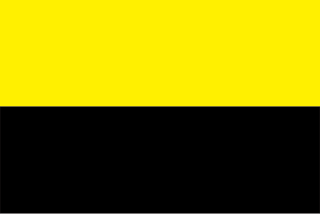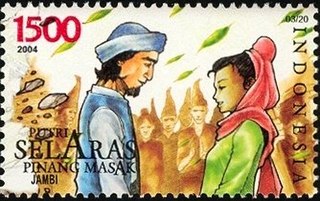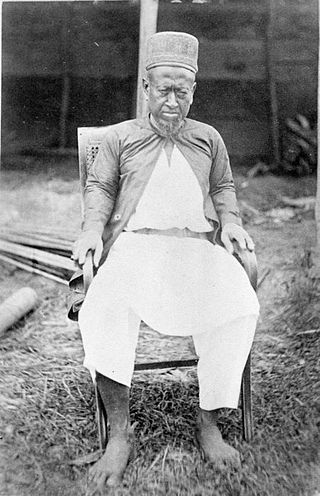
Bendahara was an administrative position within classical Malay kingdoms comparable to a vizier before the intervention of European powers during the 19th century. A bendahara was appointed by a sultan and was a hereditary post. The bendahara and the sultan shared the same lineage.
Negara Daha was a Hindu kingdom successor of Negara Dipa that appears in the Hikayat Banjar. It was located in what is now the Regency of Hulu Sungai Selatan, Province of South Kalimantan, Republic of Indonesia.

Sultan Thaha Syaifuddin Airport, formerly known as Palmerah Airport, is in Jambi City in the Jambi province of Indonesia. It is located in the Paalmerah suburb of Jambi. The airport is named after Thaha Syaifuddin, the last Sultan of Jambi (1816–1904).
Muhyiddin ibni Abdul Jalilul Akbar was the 15th Sultan of Brunei and the fourth son of Sultan Abdul Jalilul Akbar. He took the throne after defeating his opponent, Sultan Abdul Hakkul Mubin during the Brunei Civil War. Notably, he also attempted to return the throne back to the origin bloodline via Sultan Muhammad Ali's family.

The Sultanate of Deli was a 1,820 km2 Malay state in east Sumatra founded in 1632 when a commander of the Aceh Sultanate, Gocah Pahlawan, conquered the area during the reign of Iskandar Muda. A tributary kingdom from 1630 it was controlled by various sultanates until 1814, when it became independent and broke away from the Sultanate of Siak.

The Sultanate of Siak Sri Indrapura, often called Sultanate of Siak, was a kingdom that was located in present-day Siak Regency, and nearby other regions from 1722 to 1949. It was founded by Raja Kecil, who had close relations with the Johor Sultanate, after he failed to seize the Johor throne. The polity expanded in the 18th century to encompass much of eastern Sumatra as it brought various communities under its control through warfare and control of trade between the interior of Sumatra and the Malacca Strait. The Dutch colonial state signed a series of treaties with the Siak rulers in the 19th century, which reduced the area of state influence to the Siak River. For the remainder of the Dutch colonial era, it operated as an independent state with Dutch advisors. After Indonesia's Independence was proclaimed on 17 August 1945, the last sultan of Siak, Sultan Syarif Kasim II, declared his kingdom to join the Republic of Indonesia.

Sultanate of Banjar was a sultanate located in what is today the South Kalimantan province of Indonesia. For most of its history, its capital was at Banjarmasin.
Muhammad Ali ibni Muhammad Hasan, also known as Marhum Tumbang di Rumput, was the 13th Sultan of Brunei. His murder would later go on to spark the beginning of the Brunei Civil War between his killer and Sultan Muhyiddin, which a protracted civil war of succession that broke out and lasted for several years.

Riau-Lingga Sultanate, also known as the Lingga-Riau Sultanate, Riau Sultanate or Lingga Sultanate was a Malay sultanate that existed from 1824 to 1911, before being dissolved following Dutch intervention.

The Indonesian Malaysians are Malaysian citizens of Indonesian ancestry. Today, there are many Malaysian Malays who have lineage from the Indonesian archipelago and have played an important role in the history and contributed to the development of Malaysia, they have been assimilated with other Malay communities and are grouped as part of the foreign Malays or anak dagang in terms of race. The Malaysian census does not categorize ethnic groups from the Indonesian archipelago as a separate ethnic group, but rather as Malay or Bumiputera.

The Sultanate of Palembang Darussalam was a sultanate in Indonesia whose capital was the city of Palembang in the southern part of the Indonesian island of Sumatra. It was proclaimed in 1659 by Susuhunan Abdurrahman (1659–1706) and dissolved by the colonial government of the Dutch East Indies on October 7, 1823. In 1825, its last ruler, Sultan Ahmad Najamuddin, was arrested and sent into exile on the island of Banda Neira in the Moluccas.

Habib Muhammad bin Yahya or better known as the title of Prince Noto Igomo was an Indonesian scholar from Hadhramaut who became the Grand Mufti of Kutai during the reign of Sultan Aji Muhammad Alimuddin (1899-1910).

Raden Aria Wangsakara was a seventeenth century local chief, muslim cleric and patriot originated from Sumedang, who is generally credited as one of the founders of Tangerang, a city in Indonesia which is now within the Jakarta metropolitan area. In November 2021 he was declared as a national hero by president Joko Widodo.
Nasruddin ibni Besar Abdullah, sometimes spelled Nassaruddin and posthumously named Marhum di Kianggeh, was the self-proclaimed 16th Sultan of Brunei and the grandson of Sultan Abdul Jalilul Akbar. It was under his reign that the first gold coins or pitis were introduced, with the name Nasiruddin Malik al Zahir.

Pengiran Haji Mohammad bin Pengiran Abdul Rahman Piut, commonly referred to by his title Pengiran Temenggong and nicknamed National Hero, was a Bruneian nobleman, teacher and politician who formerly held several high-ranking positions which included being a member of the State Council, Privy Council, and the Islamic Religious Council. Notably, he is one of the founding members of the Royal Brunei Yacht Club and the Chairman of the Brunei Boxing Association.

Inderapura, also known as Ujung Pagaruyung, was a kingdom located in the Pesisir Selatan Regency, present-day West Sumatra, bordering Bengkulu Province and Jambi. Officially, the kingdom was a vassal of the Pagaruyung Kingdom, although in practice it was independent and free to manage its internal and external affairs. The kingdom in its heyday covered the west coast of Sumatra from Padang in the north to Sungai Hurai in the south. Inderapura's most important products were pepper and gold.

Tuanku Ahmad Salim or Ahkmad Barus II, commonly known by his Turkish title of Datuk Paduko Berhalo, was the founder and first king of the Kingdom of Jambi, he originated from the Ottoman Empire. He ruled from 1460 to 1480, with his wife, Putri Selaras Pinang Masak. In the Malay community of Jambi, he has become part of the communal memory and mythology.

Ahmad Nazaruddin also known as Panembahan Prabu, was the 21st Sultan of Jambi and ruled 1858 to 1881. He was the uncle of Sultan Thaha Syaifuddin. Under Sultan Thaha's rule, he served as the Pangeran Ratu of Jambi.
The Bugis-Malay, also known as Malay-Bugis, Melayu-Bugis or Peranakan Bugis, refers to a cultural and ethnic group with heritage rooted in both Malay and Bugis communities, typically comprising individuals of mixed Malay and South Sulawesi ancestry. This group descends from multiple waves of migration from South Sulawesi, particularly to Johor and Riau Archipelago, as well as Selangor, Singapore and other areas, between the 17th and early 20th centuries.


















